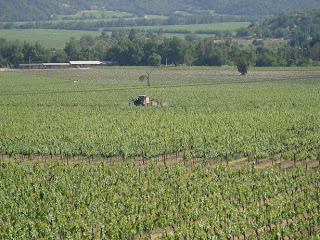Side trip to Valparaiso on the Pacific coast went very well. The mini bus picked me up at my hotel at 9 am and by 9:30 the big bus (41 tourists) took off on our drive west to the Pacific Coast. The Andes visible on the east side of Santiago and the Cordilleras close by, surrounding the city. We have a beautiful sunny day with Samuel, our guide and Carlos our driver (different from Friday). We went through 3 or 4 tunnels, under the mountains, making driving time a lot shorter than it would if we had to drive up, over, and down again. The one in Santiago is approx 4 km long; one of the tunnels today was 3 km long.
Can’t remember if I mentioned that I’m having a very difficult time understanding the Spanish here, and many of them have a hard time understanding me. It sounds like it’s Spanish, but mixed in with Portuguese, and whatever it is, it is spoken extremely fast. Four countries so far with no communication problems, no idea what is happening here in Chile. Well today on the bus Samuel cleared up the matter; they speak Portoñol (like Spanglish), a mixture of Portuguese and Spanish. The guides all speak Spanish so at least I have no problem there; and with this tour company, they also speak English and Portuguese.
Background info from guide: Chile is comprised 80% of mountains, leaving only 20% to desert and valleys. There are approximately 2,000 volcanoes here, 60 of which are still active. There is a huge earthquake somewhere in Chile approximately every 30 years; the big one was last year 8.8 on the Richter scale 600 km south of Santiago, near Concepcion . Santiago felt it as an 8.3! In 1960, Valparaiso was hit by 9.5 earthquake, and the one in 1905 (before the Richter scale existed) destroyed 90% of the city. The country is 4,300 km long (from the Atacama high desert in the North, to Patagonia in the South) but only 180 km across at its widest point.
The biggest industry here is mining, they have two of the world’s biggest copper mines; one is open pit (Chuquicamata in the North of Chile), and the other has 2,400 km of tunnels (El Teniente in the Sewell area of Chile). Neither is the site of the mining accident that made the news in 2010.
The 2nd biggest industry is wood and wood products. We drove through planted forests of pines from Canada and Eucalyptus from Australia (they are the fastest growing trees). The 3rd industry is Fisheries from the ocean and the 4rth is agriculture.
Our 1 ½ hour drive took us through some beautiful valleys; the first one agricultural with fruit trees (Oranges, kiwis, apples, olives, etc) and vegetables (you name it, they’ve got it). The second valley, Casablanca, was filled with vineyards! What a beautiful site: 75% are white wines, the other 25% are mostly Cabernet Sauvignon & Merlot.
Wine growing in this area started as soon as the Spanish arrived, with Mission grapes that allowed them to produce their drinking wine. After the 1810 independence, the growers expanded with French and German vines. There are over 200 wineries in Chile today, and although the people here drink an average of 17 litres/year/person, the beer drinking surpasses this at 34 litres/year/person.
We arrived first at Viña del Mar, a tourist town along the coast just beside Valparaiso. This entire coastal area was hit by a huge earthquake last year, which caused considerable damage. Many old buildings, and some new ones, had to be abandoned.
Filled with skyscrapers, old and new mansions, and beaches.
Although the beaches were full of people sunning themselves, there was no one in the water because it is too cold. Because of the Humboldt currant, it rarely warms up enough to allow for swimming, but it makes for great fishing. And that’s what I had for lunch; no idea what type of fish it was since it was the tourist menu used for all the “Bus” tourists who only have 1 ½ hours for lunch. Add to that a nice glass of chilled Chardonnay and everything is good.
After lunch we drove to Valparaiso, the oldest port in Chile. It enjoyed a booming business from the very first since navigators would make port here after crossing the straight of Magellan; but after the Panama Canal was built, the city fell on hard times and has never returned to its former glory. A lot of renovated/restored buildings beside new ones, and beside older abandoned ones that are falling apart, or sometimes still lived in. The rich and the poor are very obvious everywhere here.
We ended our tour at the harbor
And our last view of Valparaiso was of the shanty towns on the outskirts
Return to Santiago was supposed to be quicker, however construction on the road outside Valparaiso combined with rush hour traffic meant a very late return; 7:30 by the time I was dropped off at my hotel. Oh, and why do they call it “rush” hour, since every car is moving at a snail’s pace?






























No comments:
Post a Comment